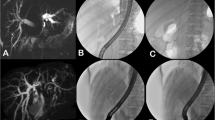Abstract
Introduction
Endoscopic biliary drainage is the treatment of choice for inoperable hilar cholangiocarcinoma (so-called Klatskin tumor). Cholangitis is the main complication post-endoscopic retrograde cholangiopancreatography (ERCP) in Klatskin patients, specially when medium contrast is injected into biliary tree that could not be subsequently drained. Bacterial cholangitis is the principal cause of mortality in these patients. The aim of this study is to analyze cholangitis rate resulting from the use of air versus iodine contrast to obtain cholangiography during ERCP.
Methods
In 9 years, 188 inoperable Klatskin patients were recruited and divided into two groups: iodine (A) or air (B) contrast cholangiography, respectively. We used air or iodine contrast to obtain cholangiography before hilar stricture stenting. We retrospectively compared these data in both groups.
Results
The group B had a significant lower rate of cholangitis than group A in Bismuth type II (p < 0.05), in Bismuth type III (p < 0.05), and in the Bismuth type IV population (p < 0.05).
Conclusion
The air contrast cholangiography is a safe and effective method, and it appears justified as a routine procedure to prevent or reduce the risk of post-ERCP cholangitis, specially in Klatskin patients (p < 0.005).


Similar content being viewed by others
References
Altemeier WA, Gall EA, Zinninger MM, Hoxworth PI (1957) Sclerosing carcinoma of the major intrahepatic bile ducts. AMA Arch Surg 75(3):450–461
Klatskin G (1965) Adenocarcinoma of the hepatic duct at its bifurcation within the porta hepatis: an unusual tumor with distinctive clinical and pathological features. Am J Med 38:241–256
Singhal D, van Gulik TM, Gouma DJ (2005) Palliative management of hilar cholangiocarcinoma. Surg Oncol 14:59–74
Brown KT, Covey AM (2008) Management of malignant biliary obstruction. Tech Vasc Interv Radiol 11:43–50
Lee SH, Park JK, Yoon WJ, Lee JK, Ryu JK, Yoon YB, Kim YT (2007) Optimal biliary drainage for inoperable Klatskin's tumor based on Bismuth type. World J Gastroenterol 13(29):3948–3955
Geller A (2009) Klatskin tumor palliative therapy: the jury is still out or may be not yet in. Gastrointest Endosc 69:63–65
Chamberlain RS, Blumgart LH (2000) Hilar cholangiocarcinoma: a review and commentary. Ann Surg Oncol 7(1):55–66
Semelka RC, Shoenut JP, Kroeker MA, Hricak H, Minuk GY, Yaffe CS (1992) Bile duct disease: prospective comparison of ERCP, CT, and fat suppression MRI. Gastrointest Radiol 17:347–352
Hintze RE, Abou-Rebyeh H, Adler A, Veltzke-Schlieker W, Felix R, Wiedenmann B (2001) Magnetic resonance cholangiopancreatography-guided unilateral endoscopic stent placement for Klatskin tumors. Gastrointest Endosc 53:40–46
De Palma GD, Galloro G, Siciliano S, Iovino P, Catanzano C (2001) Unilateral versus bilateral endoscopic hepatic duct drainage in patients with malignant hilar biliary obstruction: results of a prospective, randomized, and controlled study. Gastrointest Endosc 53:547–553
Ozden I, Tekant Y, Bilge O, Acarlı K, Alper A, Emre A, Rozanes I, Ozsut H, Arıogul O (2005) Endoscopic and radiologic interventions as the leading causes of severe cholangitis in a tertiary referral center. Am J Surg 189:702–706
Bai Y, Gao F, Zou DW, Li ZS (2009) Prophylactic antibiotics cannot prevent endoscopic retrograde cholangiopancreatography-induced cholangitis: a meta-analysis. Pancreas 38(2):126–130
Deviere N, Baize M, De Toeuf S, Cremer M (1988) Long-term follow-up of patients with hilar malignant stricture treated by endoscopic biliary stenting. Gastrointest Endosc 34(2):95–101
Figueras J, Llado Garriga L, Lama C, Pujol-Rafols J, Navarro M, Martinez-Villacampa M (1998) Resection as elective treatment of hilar cholangiocarcinoma (Klatskin tumor). Gastroenterol Hepatol 21:218–223
Raper SE, Barker ME, Jones AL, Way LW (1989) Anatomic correlates of bacterial cholangiovenous reflux. Surgery 105:352–359
Motte S, Deviere J, Dumonceau JM, Serruys E, Thys JP, Cremer M (1991) Risk factors for septicemia following endoscopic biliary stenting. Gastroenterology 101(5):1374–1381
Mosca S, Secondulfo M, Defez M, Calise F (2001) Air contrastography technique for successful urgent ERCP in high risk allergic patient. Am J Gastroenterol 96(12):3458–3460
Lim PL, Porter KG (1999) Air as contrast for cholangiography in a patient with a history of allergy to radiopaque media. Endoscopy 31(2):S9
Bismuth H, Corlette MB (1975) Intrahepatic cholangioenteric anastomosis in carcinoma of the hilus of the liver. Surg Gynecol Obstet 140(2):170–178
Cipolletta L, Rotondano G, Marmo R, Bianco MA (2007) Endoscopic palliation of malignant obstructive jaundice: an evidence-based review. Dig Liver Dis 39:375–388
Singh V, Singh G, Verma GR, Singh K, Gulati M (2004) Contrast-free unilateral endoscopic palliation in malignant hilar biliary obstruction: new method. J Gastroenterol Hepatol 19:589–592
Hammarström LE (2005) Role of palliative endoscopic drainage in patients with malignant biliary obstruction. Dig Surg 22:295–305
Dowsett JF, Vaira D, Hatfield AR, Cairns SR, Polydorou A, Frost R, Croker J, Cotton PB, Russell RC, Mason RR (1989) Endoscopic biliary therapy using the combined percutaneous and endoscopic technique. Gastroenterology 96(4):1180–1186
Author information
Authors and Affiliations
Corresponding author
Rights and permissions
About this article
Cite this article
Pisello, F., Geraci, G., Modica, G. et al. Cholangitis prevention in endoscopic Klatskin tumor palliation: air cholangiography technique. Langenbecks Arch Surg 394, 1109–1114 (2009). https://doi.org/10.1007/s00423-009-0548-y
Received:
Accepted:
Published:
Issue Date:
DOI: https://doi.org/10.1007/s00423-009-0548-y




